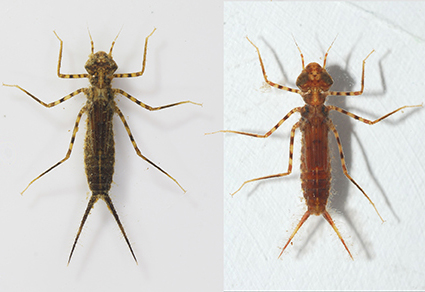Abstract
The final stadium larvae of the following four species of south-east Asian Chlorocyphidae are described and compared: Aristocypha fenestrella (Rambur), Heliocypha biseriata (Selys), Libellago hyalina (Selys) and Sundacypha petiolata (Selys), including both sexes for the latter two species. Excepting one L. hyalina specimen from Brunei, identified by supposition based on habitat, all specimens were identified by comparing and matching the mitochondrial marker COI with that of known adult specimens from Sarawak, Brunei and several localities throughout tropical Asia. The specimens presented close matches with all adults in this gene. An assessment of the efficacy of this method of identification is provided, noting that in some cases close species cannot be separated by bar-code matching and ultimate determination is partially based on known distributions of adults. Some aspects of the relationships among genera revealed by the genetic analyses are also discussed. In addition, an exuvia of Libellago lineata (Burmeister) from northern Thailand, identified by supposition, is partially described for the purpose of comparison with L. hyalina. For the morphological analysis the unique features of chlorocyphid anatomy are discussed, and some new terminology is introduced. Overall, the morphological analysis revealed numerous clear differences between the four species studied, and comparisons with available literature suggest that some of these may be characteristic of their genera. It is also evident that in some cases clear interspecific differences occur within genera. It is however concluded that a generic level larval key for the Oriental region Chlorocyphidae based on morphology may never be attainable, although local generic or even species level keys addressing the fauna of limited geographic areas may be possible in many places, especially as the larvae of more species come to be known and described in detail.
References
- Dijkstra, K-D.B., Kalkman, V.J., Dow, R.A., Stokvis, F.R. & van Tol, J. (2014) Redefining the damselfly families: a comprehensive molecular phylogeny of Zygoptera (Odonata). Systematic Entomology, 39, 68–96. https://doi.org/10.1111/syen.12035
- Dow, R.A., Butler, S.G., Ngiam, R.W.J. & Reels, G.T. (2021) Previously unpublished Odonata records from Sarawak, Borneo, part V: Odonata from the southwest of Sarawak, including the first records from the Bungo Range National Park. International Dragonfly Fund Report, 159, 1–77.
- Dow, R.A., Choong, C.Y., Grinang, J., Lupiyaningdyah, P., Ngiam, R.W.J. & Kalkman, V.J. (2024) Checklist of the Odonata (Insecta) of Sundaland and Wallacea (Malaysia, Singapore, Brunei, Indonesia and Timor Leste). Zootaxa, 5460 (1), 1–122. https://doi.org/10.11646/zootaxa.5460.1.1
- Folmer, O., Black, M., Hoeh, W. Lutz, R. & Vrijenhoek, R. (1994) DNA primers for amplification of mitochondrial cytochrome coxidase subunit I from diverse metazoan invertebrates. Molecular Marine Biology and Biotechnology, 3 (5), 294–299.
- Fraser, F.C. (1919) The larva of Micromerus lineatus. Records of the Indian Museum, 16, 197–198. https://doi.org/10.26515/rzsi/v16/i2/1919/162807
- Fraser, F.C. (1928) Indian dragonflies, Part XXX. Journal of the Bombay Natural History Society, 32, 683–691.
- Fraser, F.C. (1934) The fauna of British India, including Ceylon and Burma. Odonata. Vol. II. Taylor & Francis Ltd., London, xxiii + 398 pp.
- Hebert, P.D.N., Penton, E.H., Burns, J.M., Janzen, D.H. & Hallwachs, W. (2004) Ten species in one: DNA barcoding reveals cryptic species in the neotropical skipper butterfly Astraptes fulgerator. Proceedings of the National Academy of Sciences of the United States of America, 101 (41), 14812–14817. https://doi.org/10.1073/pnas.0406166101
- Ishida, K. (1996) Monograph of Odonata larvae in Japan. Hokkaido University Press, Sapporo, 446 pp.
- Katoh, K., Asimenos, G. & Toh, H. (2009) Multiple alignment of DNA sequences with MAFFT. Methods in Molecular Biology, 537, 39–64. https://doi.org/10.1007/978-1-59745-251-9_3
- Kumar, A. (1973) Descriptions of the last instar larvae of Odonata from the Dehra Dun Valley (India), with notes on Biology I. (suborder Zygoptera). Oriental Insects, 7, 83–118. https://doi.org/10.1080/00305316.1973.10434207
- Kumar, A. & Prasad, M. (1977) On the larvae of Rhinocypha (Odonata: Chlorocyphidae) from Garhwal hills. Oriental Insects, 11, 547–554. https://doi.org/10.1080/00305316.1977.11090927
- Larsson, A. (2014) AliView: A fast and lightweight alignment viewer and editor for large datasets. Bioinformatics, 30, 3276–3278. https://doi.org/10.1093/bioinformatics/btu531
- Laidlaw, F.F. (1920) Notes on some interesting larvae of dragonflies (Odonata) in the collection of the Indian Museum. Records of the Indian Museum, 19, 185–187. https://doi.org/10.26515/rzsi/v19/i5/1920/163534
- Lieftinck, M.A. (1947) Two interesting new insular Rhinocypha from Malaysia (Odon.). Tijdschrift voor Entomologie, 88, 215–224.
- Lieftinck, M.A. (1962) Odonata. Insects of Micronesia, 5 (1), 1–95. https://doi.org/10.1007/978-94-015-1100-1_1
- Ng, C.Y. (2024) Freshwater Macroinvertebrates in Hong Kong: Odonata: Heliocypha perforata. Available from: https://www.biosch.hku.hk/ecology/staffhp/dd/macroinvertebrates/Odonata/Chlorocyphidae/Rhinocypha_perforata.html (accessed 1 July 2024)
- Ngiam, W.J. & Ng, M.F. (2022) A photographic field guide to the dragonflies & damselflies of Singapore. John Beaufoy Publishing, Oxford, 340 pp.
- Ratnasingham, S. & Hebert, P.D.N. (2007) BOLD: the barcode of life data system (www.barcodinglife.org). Molecular Ecology Notes, 7, 355–364. https://doi.org/10.1111/j.1471-8286.2007.01678.x
- Suhling, F., Müller, O. & Martens, A. (2014) The dragonfly larvae of Namibia. Libellula, Supplement 13, 5–106.
- Sugimura, M., Ishida, S., Kojima, K., Ishida, K. & Aoki, T. (2001) Dragonflies of the Japanese Archipelago in Color. English Edition. Hokkaido University Press, Sapporo, 641 pp.
- Steinhoff, P.O.M. (2015) Results of Odonata larval rearing in the Gunung Mulu National Park, Sarawak, Malaysia from April to August 2014. International Dragonfly Fund Report, 78, 1–11.
- van Tol, J. (1992) An annotated index to names of Odonata used in publications by M.A. Lieftinck. Zoologiische Verhandelingen, 279, 1–263.
- Xu, Q.-H. (2015) Description of the final stadium larva of Heliocypha perforata perforata (Percheron), with discussion of the taxonomic characters of the larvae of the genus Heliocypha Fraser (Odonata: Zygoptera: Chlorocyphidae). Zootaxa, 3926 (1), 137–141. https://doi.org/10.11646/zootaxa.3926.1.8


